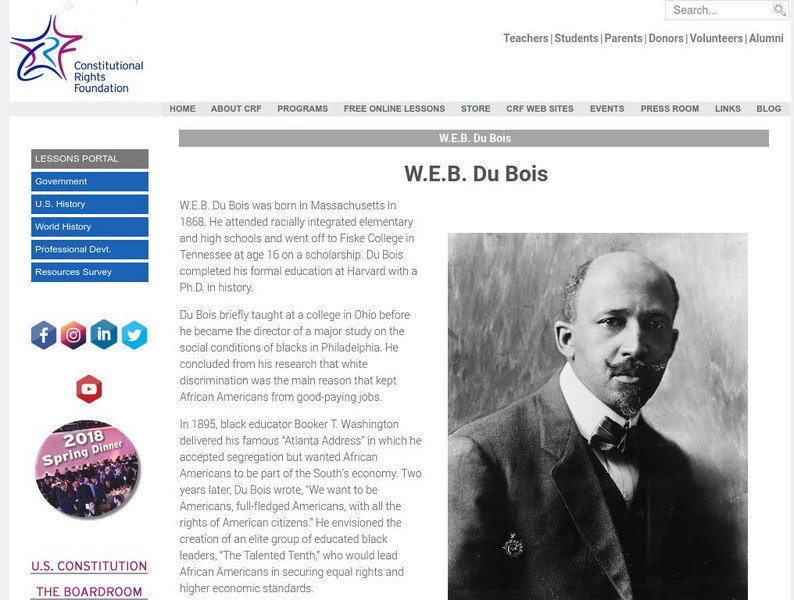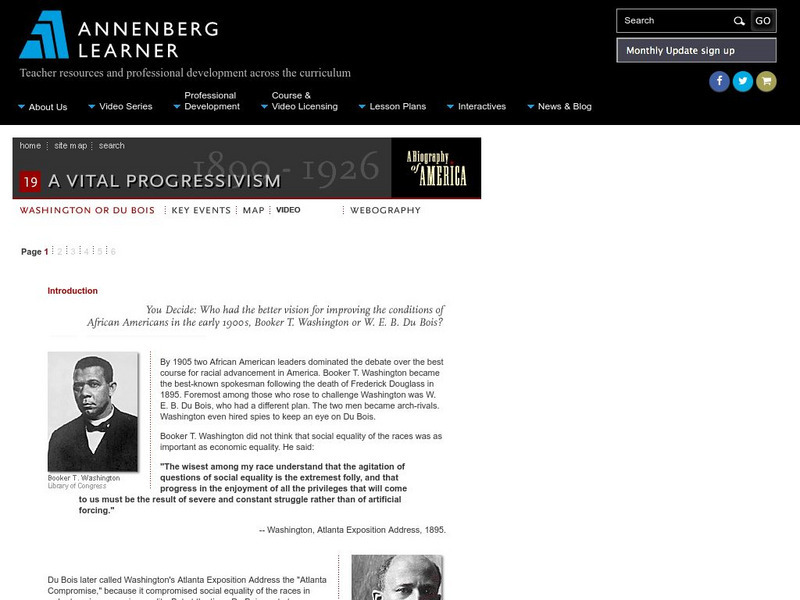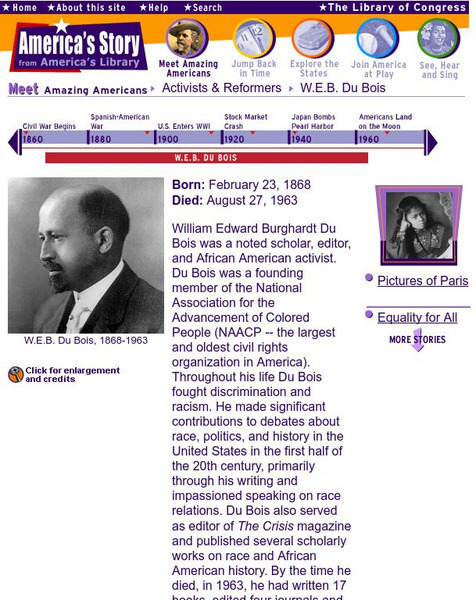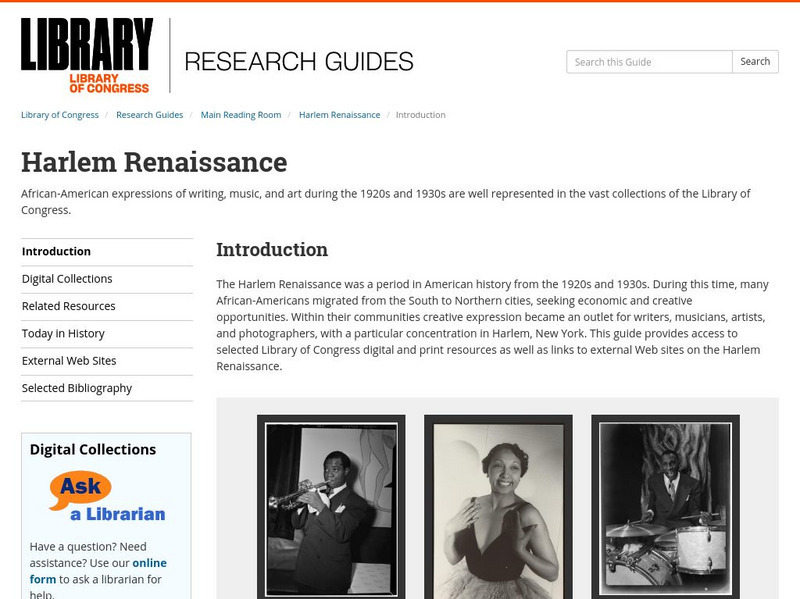Albert Shanker Institute
Strategizing for Freedom
Booker T. Washington, W.E.B. DuBois, Marcus Garvey, and A. Philip Randolph developed different views on how to advance civil rights for African Americans. Class members research these famous figures and their strategies before developing...
American Institute of Physics
Physicist Activist: Dr. Elmer Imes and the Civil Rights Case of Juliette Derricotte
Elmer Imes was not only a brilliant physicist but also a civil rights activist. After an introductory lecture, groups read two articles about a traffic accident that killed one Fisk University student and injured several others. The...
American Institute of Physics
Historical Detective: Edward Alexander Bouchet and the Washington-Du Bois Debate over African-American Education
Young scientists meet Edward Alexander Bouchet who, in 1876, was the first African American to receive a PhD in Physics. This two-part lesson first looks at the debate between Booker T. Washington and W.E.B. Du Bois about the type of...
Facing History and Ourselves
The Legacies of Reconstruction
The final lesson in the seven-resource Reconstruction Era collection examines the legacies of Reconstruction. Class members investigate why the period has been called an "unfinished revolution," "a splendid failure," and "the second...
Facing History and Ourselves
A Contested History
Memories of and interpretations of history change—that's the key takeaway from a lesson that has young historians compare the story of the Reconstruction Era as told by the historians of the Dunning School to the view of scholars today...
Facing History and Ourselves
Violence and Backlash
Revolution and counterrevolution. Protest and counter-protest. Collaborators and bystanders. The focus of the fifth resource in the Reconstruction Era and Fragility of Democracy series is on the political violence that followed Radical...
EngageNY
Grade 11 ELA Module 2: Unit 2, Lesson 14
It's time to put it all together! Using the resource, scholars complete an end-of-unit assessment. They write a multi-paragraph essay comparing Audre Lorde's "From the House of Yemanjá" or "An Address by Elizabeth Cady Stanton" to...
EngageNY
Grade 11 ELA Module 2: Unit 2, Lesson 13
Two minds are better than one. Learners engage in an evidence-based discussion to identify central ideas in Audre Lorde's poem "From the House of Yamanjá" and one additional nonfiction text. They complete a Cross-Evidence Collection Tool...
EngageNY
Grade 11 ELA Module 2: Unit 2, Lesson 12
Why is it important to make connections across texts? Scholars discover the answer with instructional activity 12 of 14 from the Grade 11 ELA Module 2: Unit 2 series. Pupils analyze the development of ideas in three nonfiction texts,...
CHPCS
The United States in the 1920s: The New Negro Movement and the Harlem Renaissance
Music, writing, and activism all tell the story of history! The resource uses these elements and more in a presentation to discuss the Jazz Age and Harlem Renaissance. Your class views biographies, discusses important events, and...
PBS
Booker T. Washington: Orator, Teacher, and Advisor
Imagine teaching yourself to read and write—do you think you could do it? Scholars analyze how Booker T. Washington went from a slave learning to read to a leading educator in the United States. Using video clips, speeches, and primary...
American Public Media
Say It Plain: Speech to Atlanta Cotton States and International Exposition
Booker T. Washington made a consequential speech in Atlanta in 1895, known now as the Atlanta Compromise. Read about the speech, the consessions Washington felt African-Americans needed to make, and the context in which the speech was...
Library of Congress
Loc: Naacp: The New Negro Movement
Look through the items in this Library of Congress exhibition, NAACP: A Century in the Fight for Freedom. This part of the exhibition deals with events the NAACP was involved with in the early 20th century just before the Great...
Yale University
Avalon Project: African Americans Biography, Autobiography and History
Five primary source materials on African American history: I Have a Dream by Martin Luther King, Jr., My Bondage and Freedom by Frederick Douglass, The Narrative of Sojourner Truth, The Souls of Black Folk by W.E.B. Du Bois, Up From...
John F. Kennedy Center
The Kennedy Center: Arts Edge: Drop Me Off in Harlem
A collection of biographies, video and audio clips, and photos offer a look at the people, locations, and themes of the Harlem Renaissance.
National Humanities Center
National Humanities Center: Toolbox Library: African Americans, the Gilded and the Gritty: 1870 1912
A speech by Mary Church Terrell, a letter by Booker T. Washington, a letter by W.E.B. DuBois, and the Niagara Movement's Declaration of Principles describe African American civil rights strategies in the early-twentieth century.
Digital History
Digital History: Two Paths Towards Equality [Pdf]
During the time of rising segregation in the late 19th century two African-American leaders offered two opposite views about how to advance civil rights for African-Americans. Read about the philosophies of those leaders. Booker T....
Other
Finding Dulcinea: w.e.b. Du Bois, Civil Rights Pioneer and Social Historian
A biographical profile of W.E.B. Du Bois, an American civil rights activist (1868-1963), who worked to promote equal rights for African Americans.
Other
W.e.b. Du Bois: Black Reconstruction in America 1860 1880
In this article, the book Black Reconstruction in America by W.E.B. Du Bois is reviewed by Keeanga-Yamahtta Taylor. This book was written to convey the experiences of African Americans during and after the Civil War, which other history...
Constitutional Rights Foundation
Constitutional Rights Foundation: w.e.b. Du Bois
Article outlining the ideas, life and career of W.E.B. Dubois.
Annenberg Foundation
Annenberg Learner: You Decide: Washington or Du Bois?
During the early Progressive Era, two leaders dominated the debate over the best course for racial advancement in America. Who had the better vision for improving the conditions of African Americans in the early 1900s, Booker T....
Library of Congress
Loc: America's Story: w.e.b. Du Bois
A brief biography of famous African-American, W.E.B. Du Bois. Read about his activism and his attempts to improve race relations. Hyperlinks to additional information about this important man.
Library of Congress
Loc: Web Guides: A Guide to Harlem Renaissance Materials
Presents the Library's resources as well as links to external web sites on the Harlem Renaissance, and a bibliography.
Curated OER
W. E. B. Du Bois
A speech by Mary Church Terrell, a letter by Booker T. Washington, a letter by W.E.B. DuBois, and the Niagara Movement's Declaration of Principles describe African American civil rights strategies in the early-twentieth century.








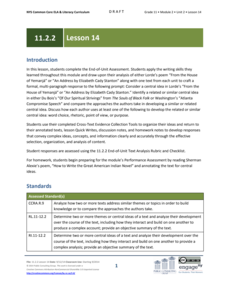









![Digital History: Two Paths Towards Equality [Pdf] Website Digital History: Two Paths Towards Equality [Pdf] Website](https://d15y2dacu3jp90.cloudfront.net/images/attachment_defaults/resource/large/FPO-knovation.png)

